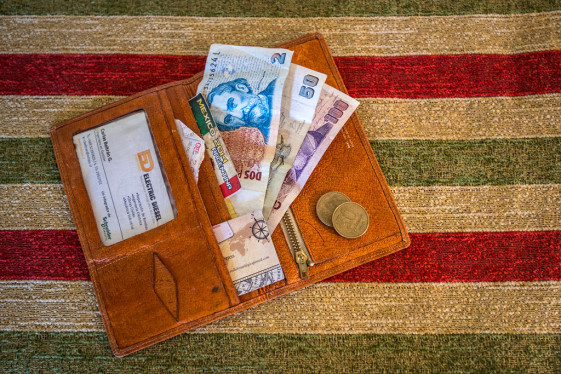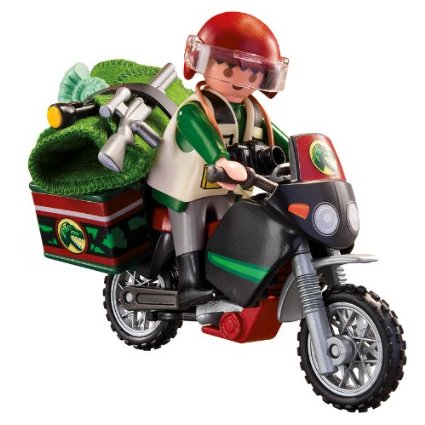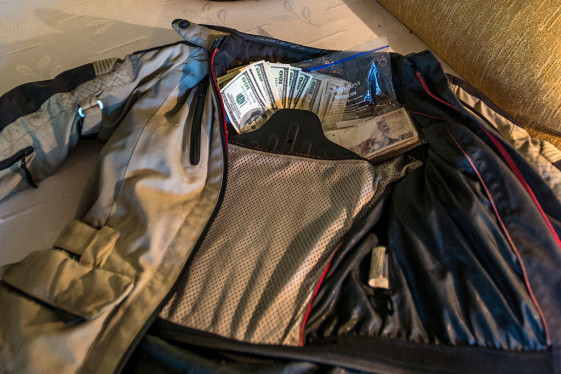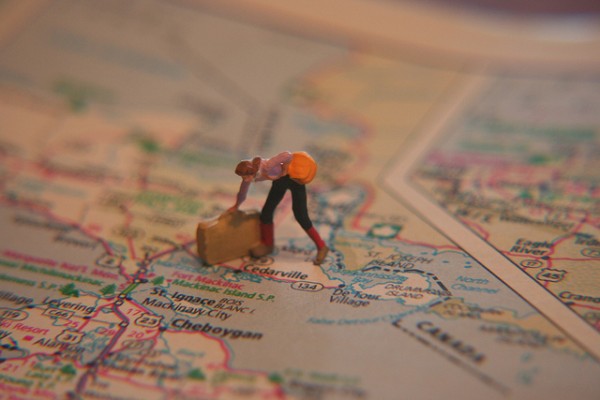Many of us daydream about making a road trip across continents, although some might imagine they’re unable to overcome the real or perceived hurdles. But what does it take to actually do it? Anyone whose jigsaw pieces in their life can coalesce—and respectfully, not everybody’s can—simply a commitment to the decision to go is all it takes. Followed by doing whatever is necessary to make it happen. It sounds too easy, but in reality it really is! The hardest part happens right at the very beginning when you have to release all the things that hold you from doing it in the first place. Having reached a point in our 9-5 lives that no longer reaped enough intrinsic reward, the time came for a change and we decided on a big one. Once we engaged in a ‘It’s time for a talk’ chat, we pinned down a departure date, or rather, the shipping agent sent us one, and the pieces began slotting into place. By “slotting into place,” I mean it still took a degree of work but at least with every task, we were one step closer to leaving.
Moto-travel involves one step: going
But where to start? Is it better to throw caution to the wind and just go where the road takes you, or to indulge a bulletproof itinerary? Organising your first big two-wheel adventure can feel like a daunting task. There is much to consider and even more to research. Someone wizened said “Each research session makes the trip look harder and harder, so we’ve decided to stop researching,” which is a gem to keep in the back of your mind. Particularly if you find yourself waist-deep in pre-trip planning activities.
Chris Scott’s Adventure Motorcycling Handbook, Achievable Dream: Motorcycle Adventure Travel Guide DVD box set and the Haynes Adventure Motorcycling series by Robert Wicks are solid starting points. We got away with doing the bare minimum because the Americas is such an easy set of continents through which to travel. Central Asia for example may well prescribe a little more homework. Doing some groundwork for your trip will unquestionably make life simpler on the road, allow you to spend less time troubling over details, and more time enjoying yourself. But don’t sweat it, and certainly not the small stuff.

Drawing a line
Before you begin putting down places and dates on a calendar, research your destination. Take some notes, talk to those who have already done exactly what you intend to do, get the travel juices flowing. You’ll get a feel for what looks and sounds like your bag of fun. Make a ‘wish list’ of what you want to see and do. Get a map. A good one. Butler Motorcycle maps depict marvellous detail throughout the States for instance. We found everything always takes longer than anticipated. Plan for that.
You know where you’re going, roughly. You’ve acquired five latest edition guidebooks, an enviable collection of maps, nine Google search terms and three buddies who’ve been there before. Everyone possesses different information and foremost, different opinions. How are you going to sieve all that knowledge and filter what is useful so that it’s easy to reference on the road? The defining criteria you will use to select potential destinations will make your research more effective. Or, once you have all this information, ignore it. Well, most of it. Be prepared to change your best laid plans. It’s your trip, your adventure; you’ll make your own decisions and create your own experiences along the way.
Common sense
From experience, avoid treating published materials as gospel, whether printed or online. Such resources aren’t always accurate and can often be out-of-date the minute they are published. Try to verify salient information with more than one source. Consider any language barriers, safety, political situations and climate of the larger region before delving into the particulars of specific areas. An invaluable stream of the latest destination news can be drawn from fellow travellers on the road, so make friends with lots of them, as well as the locals en route. Most folks relish swopping stories and sharing the lowdown.

Shiny stickers and stamps
Genning up on visa requirements is advisable before departure as visa stipulations vary significantly across countries. Considerations include: waivers and extensions, single or multiple entries, visa types, expiration dates and maximum stays beforehand. Note that expiration isn’t the same as length of stay—meaning you have to enter the country by a certain date. Sometimes the clock starts ticking from the date the visa is issued, otherwise it commences upon entering the country. Holding up an immigration queue because you didn’t bother to ascertain a visa, or foremost, outstaying your visa’s welcome, isn’t something to undertake lightly.
Official sources found through your local consulate or your destination’s embassy always have better information because visa regulations change constantly. Do you need a Carnet de Passage for your destination country? Ask Uncle Google, he’ll know. I’m appreciative when visas can be issued online to my passport, although some require sending the travel document off to an embassy, in advance, for a shiny new sticker. We all adore those visas that are issued at the border—such as those across South America and Central America, all of which were 60 to 90-day stays to boot.
How much does a big trip cost?
The million-dollar question! How much did it cost to sit astride our motorcycles through South and Central America? The short answer is: far less than it cost us to be sat on the sofa at home. If that doesn’t make you feel like you’re missing out on something, may be nothing will. Our annual mortgage expenditure alone was as much as the yearly cost to ride from Argentina upwards for 12 months. The amount of course depends on where you’re headed and on what terrain you wish to ride, the bike you’ll be on and the trip’s duration. South East Asia would be cheaper than the United States for example, as would shipping and riding a smaller, simpler motorcycle than a liquid cooled 1200cc with a fly-by-wire throttle for example, although if that’s what the heart wants… Much equally depends on whether you prefer travelling on a shoestring or delight in a little more luxury.
We budgeted around $9,000 per person for 12 months on the road through South America, (excluding the container shipping cost and one-off excursions to Antarctica for instance.) Breaking that down, we’re somewhere on the budget-end of the middle; South America cost us around $50 per day, which covered fuel costs for us both and the bikes. That also included lodging through Latin America too from wild camping, campsites to hostels. Some will manage to do the same on a lot less; other individuals will comfortably spend double. We’ve needed extra funds for breakdowns, parts and shipping, which may’ve been down to bad luck, or simply wear and tear from joyous amounts off-road.
Five easy steps
Step 1: Set a savings goal. Make it good. Write it down: dates, times, countries, learning a new language, the Salar de Uyuni. Whatever is important to you. Step 2: Figure out what it costs. (Getting a feel for what others spend, see financial reports on smboilerworks.com and atlasrider.com.) Admittedly, some things are easy to budget. Riding from continent to continent: not so easy to budget. The process involves number crunching and possibly a spreadsheet. Start one, build in plenty of flex. Get an idea as best as you can of what it’s going to cost in terms of: shipping / flights, gas, food, motorcycle maintenance and repairs, accommodation, transport / parking / tolls, entertainment, entry fees, insurance, borders / visas / permits, miscellaneous costs from back home, and then factor in a buffer for unforeseen or one-off expenditure. Tricky at best but you need to start somewhere. Great, now you have a ballpark figure. Ouch. Step 3: Have a stiff drink. Step 4: Make a plan. This is easy. Take the number of months until departure and divide by how much money you think you will require. Step 5: Make it happen.
How does the average person afford it?
Neither of us earned silly money in our former lives. Just regular money, like most people. Your standard income university-educated professional on salary and earnings from a self-employed sole trader. It sounds obvious but start saving early. At least a year, or longer if you’re not a savvy saver. It took us well over two years. And lets face it, financial planning is one of the least appealing aspects of facilitating a life on the road. If you’re not comfortably wealthy from the outset, my advice would be to save the travel money after non-negotiable bills FIRST, not last. Cut everything else. Generally, there are five solutions to making a big trip financially manageable: cheaper living; selling stuff (no one regrets a good de-clutter and it’s less to keep in storage); earning more (getting a pay-rise or a second job); cheaper travelling or pushing your trip’s start date back.
Granted, we all live to our means but have you ever heard about the concept of not being too dumb to be poor? Namely, purposely living below your means is all that it really takes. A tried and tested method of this is to live as though you’re on a starting salary of around $24,000 per year, banking the rest into a separate account. People on minimum wage cope on their earnings, why can’t you? Similarly, if your respective other is joining you on the trip, why not both survive solely on one income and save every penny from the other person’s.

Two Wheeled Nomad’s savings plan
Currently, 21 months on the road has set us back in the region of $30,000 each, including all the unanticipated and one-off expenses. And while that might be a lot less than most of us may spend in the same period at home, the question still lingers around how we ride our bikes on $60,000 unless we have $60,000 to begin with, correct? Yes. So we must be rich, right? No! So how the heck do you generate $60,000?
Our approach involved economising every facet of our lives, starting with: setting up a direct debit on pay day, which automatically allocated a portion of our wages into a designated savings account. We sold our cottage in the country, which we were doing anyway; leasing your property might be more realistic for you. Taking the proceeds from our house, we invested in buy-to-let real estate for a passive income on the road. As did renting a tiny house in a cheap part of town. Liquidating two cars alongside the non-essentials such as premium channel television, a pricey cell phone contract and the gas utility bill when we could live just as comfortably on electric, all helped to supplement the travel fund. Walking and cycling got me fitter while my savings became fatter. Once underway with fitting those pieces of the jigsaw together, seeing the money pour into our travel fund was an incredible motivator.
Financial literacy is king: realistic budgeting and smart banking with minimal fees and maximum interest earned (both before and during the trip), consistent saving and long-term investing. Ultimately, it’s your money; you need to decide how to save it or spend it. But you don’t need to inherit a lump sum, win the lottery or take out a loan. What will work, is saving like you’re possessed, indulging in “Tiny house living,” dining in with friends as opposed to wining and dining out with them, and taking frugal strides to distance yourself from the cycle of consumerism.

Keeping it sustainable on the road
Long-term affordability is key. Fortunately, hunting down campsites (ioverlander.com and freecampsites.net are excellent), negotiating room rates (horizonsunlimited.com and advrider.com are supreme for all sorts, not least for finding suitable lodging from ‘bike-friendly’ hostels to tent space, and connecting with salt-of-the-earth folks), renting out a room (airbnb.com is a brilliant accommodation alternative; the site connects homeowners who rent out their homes to you—at a fraction of the cost of a hotel room), home-sharing within the motorcycling community (motostays.com) and couch-surfing (couchsurfing.com), have all brought our daily spend down considerably—equilibrating our budget against the one-off expenses. As have non-riding days, cooking for ourselves, dining on street food or in ‘spit and sawdust’ rustic type establishments that serve the locals the ‘menu of the day’.

What to bring?
Hah! I wish I’d adhered to ‘less is more’ having been dispensed this advice more times than I can remember. Generating a list of what you think you need, versus tailoring one based on what you actually need for your travels, will be the biggest challenge. Space and weight is at a premium so with the ‘trial and improvement’ method, your ensemble should be based on: the size of your bike and its luggage capability, your financial situation and other personal preferences. There are many gear lists online from seasoned moto-travellers (ccgadventures.wordpress.com and pikipiki.co.za), which act as a good starter for ten. It’s worth noting that anything you forget, can either be sourced or shipped. Folks all around the world need the very same things as we all do. A worthy rule of thumb is to attempt to keep a third of your pannier space free. Good luck!
Evolve a resource bank
On the road, reach out. Find friends and family along the way and get in touch (Facebook and outboundapp.org are invaluable for connecting up with travellers near each other). It’s a beautiful thing when people reach out to their own family and friends on your behalf, so you’ll end up with more to live it up, farther down the road. As well as savings or a passive income, creating revenue streams such as working while travelling; volunteering in exchange for free digs and food (visit workaway.com and grassrootsvolunteering.org); or working remotely (check fiverr.com, freelancer.com and upwork.com), may also present solutions to better afford and elongate your adventure. Daniel Rintz (open-explorers.com) completed a round the world trip having adopted his own mantra “2-wheels, 1-world, 0-money.”

Stepping off the rat wheel
Superbly done if you can convince your employer to give you unpaid leave for three months or a career break for a year. For us, we are hardworking folks and are able to adapt. Perhaps plan for the period when you return home if you are tending your resignation; the end of a trip might not seem half as sweet otherwise. We’re not overly choosy about our jobs and careers are not how we define ourselves. After the current trip concludes, we’ll work again and put some pounds back in the bank. We’ve mastered how to save money and doing it all again isn’t a deal-breaker. It’s a game-changer. We have left our old lives behind and hope to do something different going forward, something that does make getting out of bed on a Monday morning a worthwhile endeavour. And of course, we will be planning the next adventure.
To go or not to go?
I realise that for some, packing up on two wheels isn’t an immediate or available option. Although, that’s not everybody so don’t short-change yourself with the notion that life keeps getting in the way of living the life you really want. If you’re willing to make the required changes—living with a lot less actually made life much simpler once we did—then there’s nothing insurmountable stopping you. And if it will empower you to kick the side stand up and ride on the trip of a lifetime, then I hope you do.

